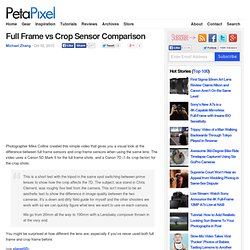

Canon 5D Mark II vs 7D. Full Frame vs Crop Sensor Comparison. Photographer Mike Collins created this simple video that gives you a visual look at the difference between full frame sensors and crop frame sensors when using the same lens.

The video uses a Canon 5D Mark II for the full frame shots, and a Canon 7D (1.6x crop factor) for the crop shots. This is a short test with the tripod in the same spot switching between prime lenses to show how the crop affects the 7D. The subject, ace stand in Chris Clement, was roughly five feet from the camera. This isn’t meant to be an aesthetic test to show the difference in image quality between the two cameras. It’s a down and dirty field guide for myself and the other shooters we work with so we can quickly figure what lens we want to use on each camera. Graduated Neutral Density Filters with Bryan Peterson.
Suppose you were at the beach just after sunset and want to use your wide-angle lens to get a composition that included the bright color-filled sunset sky, along with a foreground of sand patterns and textures.

Because you are wanting to get maximum depth of field, you'd choose the right aperture first, in this case f/22 for maximum depth of field. Then, you'd point your camera at the sky, just above the sun itself and discover that a 1/125 sec indicates a correct exposure for the sky. You then take a meter reading of the backlit sand patterns and textures of the immediate foreground, also at f/22 and discover that a 1/15 second is now indicating a correct exposure. You have just discovered a difference of three stops between the foreground and the background. Photos 6 & 7: Along the cliffs of Mohr on the west coast of Ireland, my assistant Chris Hurtt used his Tobacco Graduated filter, turning an otherwise dull and lifeless scene into one of great warmth and dignity.
Side by Side Comparison. EF 24-105mm f/4L IS USM.